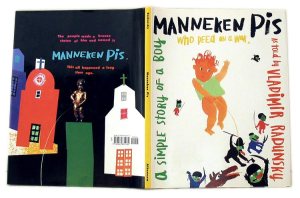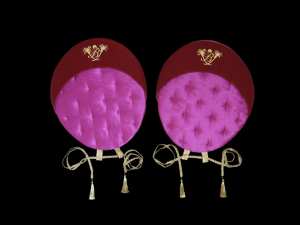ON a Beam of Light: A Story of Albert Einstein is a picture book biography written by Jennifer Berne and illustrated by Vladimir Radunsky. This book introduces young readers to Albert Einstein and celebrates curiosity in a way that will be appreciated by readers of all ages.

Two features make On a Beam of Light stand out from the vast majority of picture book biographies published.
First, in On Beam of Light, author Jennifer Berne seemlessly weaves together facts about Einstein’s life with questions that Einstein asked and answered. On one page, Berne describes Einstein’s first job working in a government office. On the following page, Berne describes Einstein, presumably on a lunch break, wondering how sugar cubes dissolve into hot tea. Just like that, Berne jumps from describing Einstein’s life in simple chronological order to describing one of Einstein’s biggest discoveries. Berne goes on to explain that Einstein was the first person to propose that all things are made of tiny particles called atoms.
Second, the entire book — from the illustrations to the endpapers to the typesetting to the front and back covers to the endnotes — is beautifully designed. Vladimir Radunsky’s design reflects great attention to detail, on one hand, and an effort to avoid busyness, on the other. The front endpaper is decorated with a plaid pattern that matches the pattern on Einstein’s suit. The back endpaper has drawings of Einstein’s favorite blue cup, formula, compass, violin and more. Radunsky’s restraint makes those things included really shine: the back cover features an Einstein quote; the author’s endnotes are succinct; a single, cleanly-design font (Didot) is used throughout…
Radunsky’s illustrations are full of energy and looseness and perfectly match this book’s subject matter. Radunsky’s illustrations were rendered with gouache, pen and ink, on textured, beige paper. He uses free-flowing, energetic black lines that seem to reflect Einstein’s free-flowing, energetic mind. The textured paper adds further energy and depth to images that might look two-dimensional on stark white paper.

The theme of curiosity is woven throughout On a Beam of Light. Berne introduces Eintstein’s character by describing a moment when Einstein was given a compass: “Albert was so amazed his body trembled. Suddenly he knew there were mysteries in the world — hidden and silent, unknown and unseen. He wanted, more than anything, to understand those mysteries.” Berne does not begin this book by describing Einstein’s childhood friends or favorite activities. Instead, Berne begins this book by describing how Einstein reacted to a compass.
Each time Berne explains one of Einstein’s discoveries, she does so by sharing a question that Einstein asked. Einstein’s discovery of atoms begins with Einstein asking how sugar cubes dissolve in hot tea and how smoke from his pipe disappears into the air. Einstein’s discovery of the relationship between speed and time begins with Einstein wondering what it would be like to ride his bicycle along a beam of light. Berne’s approach highlights the fact that Einstein’s curiosity was a key factor that led to his discoveries. Berne’s approach is also a very effective way to explain Einstein’s discoveries in a way that makes sense to young kids.
The theme of curiosity is reflected in the book’s design. The front cover and title page have images of Einstein wondering. The back cover features a quote about curiosity:
The important thing is not to stop questioning. Curiosity has its own reason for existing.
Albert Einstein

The picture book biography is a tricky beast to review. It is part picture book and part nonfiction book. The criteria that make for an excellent picture book (i.e. focus, good storytelling and beautiful design) often conflict with the criteria that make for an excellent nonfiction book (i.e. accuracy and precision and thorough citations).
On a Beam of Light is, in my view, a smashing success when reviewed as a picture book. It is also important to evaluate the book’s success as a nonfiction book, and, in particular, to consider whether the information contained in it is accurate.
Is the information in On a Beam of Light accurate? On one hand, the author is not an Einstein expert (few picture book authors are experts on the subjects they write about), and there is no subject expert credited with reviewing the book. On the other hand, the author states that she read fifty books about Einstein and cites five books that appear to be up-to-date, unbiased sources. An Einstein expert has a quote on the cover. Berne’s portrayal of Einstein feels authentic. She describes Einstein’s eccentricities without resorting to caricature. I feel satisfied that Berne has tried to paint an accurate portrait of Einstein. [Einstein experts, speak up now!]
While many Einstein biographies have been written, none match On a Beam of Light for successfully introducing young kids, ages five to ten, to Einstein. Furthermore, with On a Beam of Light, Berne does more than simply introduce readers to Einstein and the questions Einstein asked. She inspires readers to ask questions of their own.
To the next Einstein, who is probably a child now.
Jennifer Berne
Recommended for: Ages 5 and up. This is a wonderful book for teachers, librarians and parents to share with inquisitive kids. Teachers can use On a Beam of Light to help teach the scientific method or to introduce kids to famous scientists.
5 Fascinating Facts about Illustrator Vladimir Radunsky
I was so impressed by Vladimir Radunsky’s work in On a Beam of Light that I had to learn more about him. Here are five fascinating facts that I discovered from his website:
1. First, I discovered that I was not entirely unfamiliar with Radunsky’s work. Radunsky illustrated three Woody Guthrie children’s songs — Howdi Do, Bling Blang and My Dolly — that I have enjoyed reading to my kids. These three books feature silly rhymes that are very fun to read aloud to toddlers and preschoolers.
2. In addition to teaming up with Woody Guthrie (if it’s possible to “team up” with someone who is dead), Radunsky has teamed up with Bill Martin Jr. (twice), Chris Raschka (thrice) and Mikhail Baryshnikov among others.
3. Radunsky both wrote and illustrated a book entitled: Manneken Pis, a Simple Story of a Boy Who Peed on a War. Proof:

4. Radunsky also wrote and illustrated a set of four, variously-shaped books in a box entitled: Square Triangle Round Skinny. This is perhaps the most creative (and fun) introduction to shapes that I have seen.
5. By now it should come as no surprise when I share this last — and best — bit of information with you. Radunsky created an art exhibition entitled Cross Dressed that consisted of life-sized clothes for children’s book animal characters. Radunsky’s exhibition included an anaconda’s wedding dress, Ritz Hotel Paris pigeon’s uniform and Babar the Elephant slippers. I wish I could see this exhibit in person!

